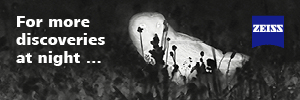| This article is incomplete. This article is missing one or more sections. You can help the BirdForum Opus by expanding it. |
Overview
One of the most important areas for terns in Britain this reserve lies in the north-east of Carlingford Lough which is a large sea inlet.
It consists of a rocky promontory, Greencastle Point, and a few small islands. Green Island which has long held the larger tern numbers is rapidly disappearing through natural erosion and is now merely a shingle spit.
The point is becoming more important for the terns as the island is gradually washed away. Blockhouse Island, off Cranfield Point to the south-east, has more vegetation and a ruined building which gives the island its name.
Birds
Notable Species
Sandwich Tern, Common Tern, Arctic Tern, and most importantly, Roseate Tern all breed here although numbers of Roseate have declined in recent decades. There are also small numbers of Eurasian Oystercatcher and Ringed Plover breeding and on Blockhouse Island, Great Cormorant and Great Black-backed Gull nest. Small numbers of Black Guillemot breed at Cranfield Point.
Check-list
Birds you can see here include:
Great Cormorant, Eurasian Oystercatcher, Common Ringed Plover, Great Black-backed Gull, Sandwich Tern, Roseate Tern, Common Tern, Arctic Tern, Black Guillemot
Other Wildlife
To do
Site Information
History and Use
To do
Areas of Interest
To do
Access and Facilities
There is strictly no access to the islands but good views can be had of Green Island from Greencastle Pier and Blockhouse Island from Cranfield Point. Greencastle Lough lies in County Down about 9km south-west of Kilkeel which is reached on the A2 from Newcastle. Annalong has hotel accommodation and there are campsites in the area.
Contact Details
For further details visit www.rspb.org.uk.
External Links
Content and images originally posted by Steve
Reviews
sav's review I know this area very well having grown up and lived there until recently. I still viist regularly. I love the solitude of the place, especially in winter months (it is much busier in summer, especially at Cranfield where there is a caravan park). The RSPB reserve at Greencastle is a small part of a very large area along the shores of Carlingford Lough. The Lough forms the border between N.Ireland and the Republic of Ireland. It is a long, narrow sea lough/ fjiord, and the range of habitats and wildlife along it's shores is diverse. The scenery in all directions is stunning (I know I'm biased but it really is superb).There are moutains on both sides of the Lough, and the landscape inland comprises mixed farmland, upland areas of moor and bog, and varied woodland and forestry. The terns are really easy to see in the summer, fishing close inshore at Greencastle, and it's a good place to compare Common and Arctic side by side. Sadly I don't think any Roseates breed there now, though there may be the odd individual there at times. Other speicies around Greencastle/ Cranfield/ Mill Bay include All year: Black Guillemot; Rock Pipit; Stonechat; Red-breasted Merganser; Common Buzzard; Peregrine (breeds locally); Sparrowhawk; Kestel; Oystercatcher; Ringed Plover; Redshank; Lapwing; Raven; Hooded Crow; Tree Sparrow; Grey Wagtail; Linnet; Bullfinch; Skylark; Reed Bunting; Shelduck; Mute Swan; Common Gull; Herring Gull; Great Black-backed Gull; Cormorant; Shag; Grey Heron; Stock Dove Oct-Mar: Great Northern Diver; Red-throated Diver; Great Crested Grebe; Slavonian Grebe )occcasional); Pale-bellied Brent Goose; Wigeon; Teal; Goldeneye; Long-tailed Duck; Scaup; Merlin (occasional); Curlew; Grey Plover; Golden Plover; Greenshank; Dunlin; Knot; Purple Sandpiper (a handful); Turnstone; Bar-tailed Godwit; Snipe; Guillemot; Razorbill; Twite; Fieldfare; Redwing; Black Redstart (occasional) Apr-Sept: Whimbrel; Common Sandpiper; Common Tern; Arctic Tern; Sandwich Tern; Cuckoo; Whitethroat; Willow Warbler; Blackcap; Sedge Warbler; Chiffchaff; Spotted Flycatcher; hirundines; Manx Shearwater & Gannets offshore.
There have recently been 2 or 3 Little Egrets in the area (still a rare bird in N Ireland) and there is undoubtedly scope for lots of rarer things to be discovered if the area was better covered throughout the year. Apart from the Greencastle? Cranfield area, there are other excellent birdwatching sites around the Lough at Rostrevor, Killowen Point, Warrenpoint, and on the southern shore, at Omeath, Carlingford and Greenore. All well worth a visit. Pros
- stunning scenery
- no other birders
- fantastic diversity of species and habitiats locally
Cons
- fairly accessible
- though a little bit off the beaten track.



